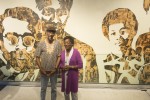Helen Singleton and Neville Garrick stood proudly in front of the oldest piece of student art in Ackerman Union, a floor-to-ceiling mural that was – until recently – covered by a false wall.
The mural, titled “The Black Experience,” was officially unveiled Wednesday night after it was covered more than 20 years ago during a renovation of the student union. Its unveiling marks the completion of a major restoration project led by Associated Students UCLA.
Seven black art students initially created the mural in the 1970s, following weeks of campus protests against the Vietnam War and the deaths of four Kent State University students. Thousands of people attended the protests, which resulted in extensive damage to Ackerman Union, including graffiti and broken windows.
Restoration of the mural began in October with fanfare from student groups and community members.
Singleton said the mural, which depicts both Garrick and herself along with the five other student artists who worked on the mural, was intended to be an expression of love. Embedded within the faces in the mural are images of important historical events and leaders throughout black history.
Singleton, who lives in Los Angeles and comes back to visit campus from time to time, said she was shocked when she returned to campus in the ’90s and did not see the mural visible. She later learned that it had not been removed but rather covered by a false wall.
It was only in 2012 that Jason Smith, a former member of the Afrikan Student Union, took the proposed mural restoration project to the ASUCLA Board of Directors. He said he learned about the mural in 2010 and was inspired to take action by a course at UCLA called “Beyond Mexican Mural: Beginning Muralism and Community Development.”
Renowned activist and former UCLA professor Angela Davis, who came to the unveiling Wednesday, said the restoration project was exciting to her because the restoration was student-driven.
“It’s wonderful that current students (not only) noticed that there was something behind the false wall, but then developed a campaign to have it uncovered,” Davis said. “Students here today get to see the vision of the black experience that was created by artists that were activists then.”
Shayla McClelland, a third-year Afro-American studies student, said she disagrees with the decision to initially cover the mural, because she thinks it represents an important historical experience.
“(Black students) have been through so much at this university, the state and nationally,” she said. “It’s very powerful to have something that represents you and your student union.”
Eric Adams, a fourth-year Afro-American studies student, said the mural’s unveiling makes him feel more comfortable at UCLA, especially given the small percentage of black students at the school.
“This is a statement that black students are welcome on this campus, because a lot of the times it feels like we are not,” he said.
Kamilah Moore, chair of the Afrikan Student Union, said she thinks the mural would add more context to social and political movements that UCLA has been at the center of.
“The mural is a way to resurface (the movements) and to cultivate conversations about race, class, history and culture in a way that will bring peace,” she said.
Roy Champawat, director of the UCLA Student Union, said the restoration of the mural is the first of its kind attempted by the organization. With funding from ASCULA, Panda Express, the Angell Foundation and the Black Alumni Association, ASUCLA began the restoration in 2013.
“One of the challenges for us (in restoring the mural) was that it goes a bit out of our area of expertise,” Champawat said. “We are not art conservationists. … We hadn’t had a lot of reason before this to get involved in restoring pieces of art that may have damage.”
With the help of the Fowler Museum and a team of art conservationists, including three undergraduate UCLA students, the mural was slowly restored over the last school year.
The last to speak before the ribbon commemorating the unveiling of the mural was cut, Singleton said she thinks the mural represents more than the history of the African American experience and its associated struggles throughout history.
“(This mural) displays not only our history and experience in this country, but the people we love,” she said “This is our experience – it’s not about hate, it’s about love.”
With that, Singleton and Garrick cut the ribbon, officially reinstalling the mural to the Ackerman Union for all to see.
